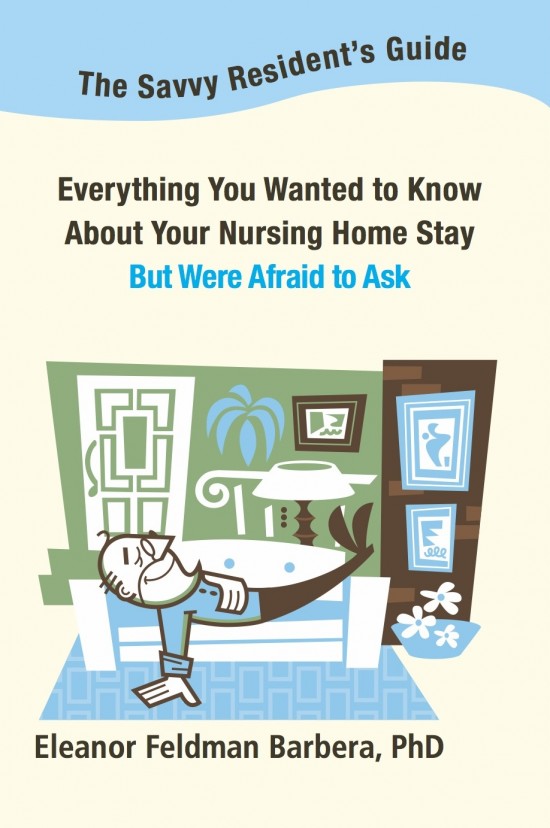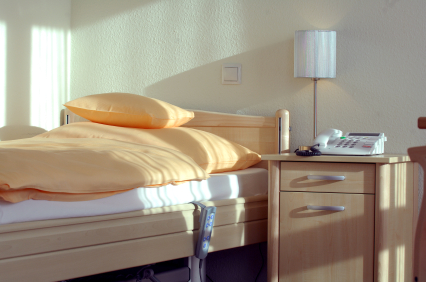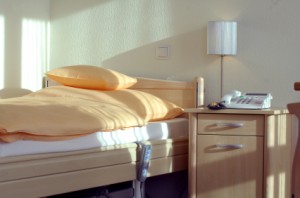Category: Bullying/Senior bullying
Posted by Dr. El - December 7, 2016 - Books/media of note, Bullying/Senior bullying, Business Strategies, Common Nursing Home Problems and How Psychologists Can Solve Them, Customer service, Dementia, Engaging with families, McKnight's Long-Term Care News

The Savvy Resident’s Guide can help set reasonable expectations for your new residents and families, leading them to view their stays in a more favorable light. To see how, download a FREE Kindle version between December 7-9th and take advantage of Holidays Savings of 20% off bulk orders of 25 or more copies through Friday, December 23rd. Use the code MCKNIGHTS at checkout.
It’s like giving people 24/7 access to an experienced nursing home shrink who tells it like it is with gentle humor and answers every question before it’s asked. Put a copy in every rehab room and watch your customer satisfaction reviews improve!
For more great resources, read my latest article on McKnight’s Long-Term Care News:

Over the past year, I’ve been involved with several exciting long-term care-related projects that I can now tell you about. In the spirit of the season, I wanted to spread some good cheer with them*, and also offer a gift.
The first is a book entitled “Bullying Among Older Adults: How to Recognize and Address an Unseen Epidemic” by Robin P. Bonifas, to which I had the honor of contributing a chapter. This volume addresses the effects of bullying among seniors and outlines actions which facilities and communities can take to address the problem. It provides step-by-step assessment strategies and anti-bullying interventions that will increase staff awareness and improve day-to-day interactions.
In another publication, fellow geropsychologists Kelly O’Shea Carney and Margaret P. Norris have put their years of experience to paper in “Transforming Long-Term Care: Expanded Roles for Mental Health Professionals.” As I state in my review of their work, “The book will … appeal to long-term care policy strategists and facility managers looking for ways to reduce costs while improving care quality and staff turnover.” The book digs deeper into the Eldercare Method (which I earlier discussed here) and outlines ways in which long-term care can make better use of its consulting psychologists.
.
.
.
And finally, I’d like to offer the opportunity to download — through this Friday — a free Kindle version of my book, “The Savvy Resident’s Guide: Everything You Wanted to Know About Your Nursing Home Stay But Were Afraid to Ask.” This large-print guidebook provides essential facility-friendly information in an entertaining format for residents and family members regarding how to make the most of their time in a nursing home. (If you like it as much as I think you will, order here by Dec. 23 for a 20% discount for purchases of 25 or more. Use the code MCKNIGHTS upon checkout.)
*Full disclosure: I do not benefit financially from mentioning the resources of my colleagues or from any purchases of their products.
For the entire article, visit:

Posted by Dr. El - May 13, 2015 - Bullying/Senior bullying, Dementia, McKnight's Long-Term Care News, Resident care, Something Good About Nursing Homes

Here’s my latest article on McKnight’s Long-Term Care News:

I’ve been fortunate enough to attend several senior living conventions recently and my enthusiasm for the experience has yet to diminish. If you haven’t yet had the opportunity to be present for a conference (or if it’s been a while since your last one), consider these reasons for attending:
• There are interesting discussions that directly relate to day-to-day work. Hearing different ideas and perspectives can offer a new way to handle problems and can help you get out of a work rut.
• The conference discourse provides a great opportunity to brainstorm, on your own or with colleagues and coworkers.
• Attendees are often equally enthusiastic about LTC and the connections made with others there can help implement changes within your organization.
• The new products offered in the expo hall can improve operations and the lives of residents and staff.
• Sharing the lessons learned with coworkers can expand the value of the conference.
If an onsite convention isn’t possible for now, consider attending a virtual event, such as the annual McKnight’s Online Expo, which not only offers educational sessions but also has chat rooms and a virtual expo hall.
My experience at ALFA
My most recent conference was the Assisted Living Federation of America convention last week in Tampa, where I spoke at the session “The Importance of Environmental Factors in Senior Living.” During my whirlwind visit to ALFA, I was also able to take in two presentations and spend time in the expo hall.
One of the sessions was on using recreational activities as a way to improve morale among residents and staff and to promote your organization in the community. I’ve spoken about these goals in my audio, “10 Steps to Making Recreation the Most Valuable Department in the Nursing Home,” and I was encouraged to hear of unique ways senior organizations have been serving these dual objectives, such as knitting caps for premature babies.
The conversation among participants helped me think about the impact that the pro-social engagement of residents has on reducing the problem of senior bullying. If seniors are busy doing good in the world, not only are they less likely to be engaging in negative behavior such as bullying, but the organization has helped to create a culture of caring.
The second talk was a roundtable on engaging staff in order to reduce turnover. The suggestions focused on hiring for attitude and training for skills, being clear about the mission of the organization, and implementing programs that reward employees for their good work.
Expo hall jewels
As usual, I searched the expo hall to find products I knew my residents would appreciate.
Having heard far too many elders complain bitterly about pureed food, I was delighted to find a company that offered puree solidified into colorful, shaped molds that were far more appetizing than typical puree. The saleslady looked askance at my glee about getting to sample her wares — but regular readers know I like to experience things from the residents’ perspective whenever possible.
For the entire article, visit:

Posted by Dr. El - March 24, 2015 - Bullying/Senior bullying, Resident care, Talks/Radio shows

Join Dr. El
Wednesday, March 25th
at 2pm Eastern Time (1pm Central Time)
for a
FREE Webinar on
4 Steps to Preventing Senior Bullying in Long Term Care
sponsored by EmLogis
To register:
About the Webinar:
Senior living communities often experience problems with bullying among residents. Join psychologist Dr. Eleanor Feldman Barbera on March 25th at 1pm central for a FREE WEBINAR as she discusses the importance of addressing bullying and outlines the path to creating an atmosphere that discourages bullying within your community.
What you will learn:
The impact of bullying
The types of behaviors considered bullying
Who is more likely to bully and to be bullied
Interventions to reduce bullying at the individual and organizational levels
Who should attend this webinar:
Administrators and assistant administrators
DONs, ADONs, department heads, nursing supervisors, charge nurses, social workers, and direct care staff
Staff training coordinators
Human resource department staff

Posted by Dr. El - March 4, 2015 - Bullying/Senior bullying, Business Strategies, McKnight's Long-Term Care News, Resident education/Support groups

Here’s my latest article on McKnight’s Long-Term Care News:

Things were different when I was a kid. People regularly drove while intoxicated. The high school archery team practiced on the football field while the track team ran around the periphery. Children bullied their peers without anyone giving it much notice.
These days, drunk driving prohibitions abound, schools are no longer casual about teens with potential weapons, and children start learning about bullies in kindergarten.
When it comes to bullying in senior communities, though, we’re still behind the times.
What is senior bullying?
According to the American Psychological Association, “Bullying is a form of aggressive behavior in which someone intentionally and repeatedly causes another person injury or discomfort. Bullying can take the form of physical contact, words or more subtle actions.
The bullied individual typically has trouble defending him or herself and does nothing to ‘cause’ the bullying.” Bullying that does not involve physical contact is sometimes referred to as “relational aggression.”
According to senior bullying expert Dr. Robin Bonifas at Arizona State University, 10% to 20% of elders in senior communities experience bullying.
Dr. Margaret Wylde of the ProMatura Group reports that senior bullying occurs in every independent living community studied in her 2014 report, “Make Them Feel at Home,” sponsored by the American Seniors Housing Association.
In that study, bullying fell into the category with the largest relationship to whether or not the community feels homelike. Study participants described problems such as “difficulties making friends, being lonely, not fitting in, not having common interests, bullying by cliques, and missing their friends.”
Wylde notes that increasing residents’ sense of being at home results in fewer departures from the independent living community and reduced staff turnover, leading to an estimated $52,242 in savings over the course of a year. (Far more than enough to fund a bullying prevention program!)
Increased media focus
Senior bullying is receiving increased attention in the mainstream media, with articles such as Paula Span’s New Old Age column, Mean Girls in Assisted Living and Jennifer Wiener’s Mean Girls in the Retirement Home. (“Mean girls” tend to engage in gossip, excluding others and establishing cliques, while male bullies are more likely to yell and threaten.)
Heightened media exposure for the issue increases the likelihood that potential residents and their adult children will be asking about bullying prevention when they’re searching for a senior living community.
Steps to reduce bullying
In order to address bullying in long-term care, several steps should be taken:
For the entire article, visit:

Posted by Dr. El - May 1, 2014 - Bullying/Senior bullying, Depression/Mental illness/Substance Abuse, McKnight's Long-Term Care News, Younger residents

Here’s my latest article on McKnight’s Long-Term Care News:

News of the recent double-homicide in a Houston nursing home arrived the morning I was to speak to a group gathered to address the needs of younger residents in long-term care. It didn’t escape anyone in the audience how serious this topic is — the alleged murderer is 56 years old and one of his two victims was 50 years old.
What can organizations do to respond to this terrible news and to reduce the chances that a similar situation could happen in their facilities? Plenty.
Calm fears
· Soothe nerves by pointing out efforts your facility takes to address agitated residents and maintain the safety of the environment (for example, the security guard, video cameras, separating residents in conflict, etc.)
· Minimize the news coverage of the event in common rooms. Residents who want to find out more information can read the newspaper or watch TV privately. It’s not helpful for most residents to listen to an anxiety-provoking rehash of information, especially when they’re unable to get up and leave the room.
Train staff
· Train staff to recognize signs of distress and mental illness in residents and have a system in place that allows the information to be communicated effectively. Aides, for example, don’t have to make a mental health diagnosis; they just need to be able to recognize when a resident is behaving differently and communicate it to the nurse. Train nurses to recognize the importance of the information and to work with the team to assess the resident and intervene appropriately. Mental health issues should be addressed as seriously as physical health concerns and staff should have enough training so that they feel comfortable doing so.
· Train your staff on how to defuse verbally and physically aggressive situations. Staff members without proper training often inadvertently precipitate conflict. (For more on this, download my free report, Stop Agitating the Residents, at MyBetterNursingHome.com.)
For the entire article, visit:

Posted by Dr. El - May 4, 2012 - Bullying/Senior bullying, Resident care

Potential Individual-Level Interventions to Reduce Bullying Among Seniors: Strategies for the Targets of Bullying
By Robin Bonifas, PhD, MSW, Assistant Professor, School of Social Work, Arizona State University, Phoenix, AZ and Marsha Frankel, LICSW, Clinical Director of Senior Services, Jewish Family & Children’s Service, Boston, MA
Welcome to our final blog addressing issues of bullying among older adults. This time we are covering how to help individuals who are the targets of bullying.
Readers will recall from blog 2 Who bullies and who gets bullied? that individuals who fall victim to bullies typically have trouble defending themselves. They do nothing to “cause” the bullying, but passive social interaction styles make them ideal targets for bullies to overpower and control.
Readers will also recall that there are two types of bullying victims, those who are passive and those who are provocative.
Passive victims tend to show a lot of emotion, are often anxious, and typically do not read social cues well. Others often perceive these individuals as shy and insecure. Among older adults, such victims may have early dementia or a developmental disorder. Sadly, minority status based on race, ethnicity, or perceived sexual orientation can also contribute to individuals being targeted for bullying because individuals who bully have difficulty tolerating individual differences.
On the other hand, provocative victims can be annoying or irritating to others, such as by intruding into others’ personal space. They are often perceived as quick-tempered and may inadvertently “egg” bullies on. Among older adults, such individuals may have a dementia-related condition that is more advanced than that of passive victims.
It is helpful to keep the above characteristics of bullying victims in mind when devising interventions to help minimize bullying. It is also critical to understand that individuals with dementia who are bullied require different interventions than individuals who do not have dementia. As readers are well aware, dementia impairs cognition and individuals in the middle stages of dementia are not able to learn new skills. Thus, intervention cannot be based on teaching these individuals how to deal with bullies. Rather, the facility staff and the environment have to fill that gap: staff members need to monitor individuals and redirect them from harm’s way. Environmental modifications can, of course, ease the staff’s burden somewhat, for example, using visual barriers that prevent wanderers from entering into others’ rooms. The interventions below are for intended for individuals who are targeted by bullies and have sufficient cognitive abilities to learn new skills.
Bullying victims can be helped by learning ways to prevent others from dominating them. Assertiveness training is a best practice approach for gaining such abilities and emphasizes the following:
- Standing up for one’s rights
- Seeking respect and understanding of one’s feelings regarding the impact of the bully’s behavior
- Managing feelings of anger
- Using direct communication strategies
- Using “I” statements
- Setting boundaries
- Creating win-win situations
Individuals who are learning assertiveness skills can initially have some difficulty differentiating assertive behavior from aggressive behavior, so it is important to really help individuals understand the difference. If this distinction isn’t clear, victims can become “victim bullies” – people who are the targets of bullying, but also bully others in return. Teaching targets to make “I” statements, as noted above, is a useful strategy to both practice assertiveness and emphasize how it is different from aggressiveness. For example, in learning how to tell a bully about the impact of his or her behavior, victims might take aggressive statements like “You make me so mad” and “You are such insensitive person” and reconstruct them into assertive statements: “When you raise your voice at the table during mealtime, I have difficulty enjoying my meal” and “When you imitate the way I talk, I feel angry and embarrassed.”
Molly Nece has a series of U-Tube videos that readers may find helpful in learning strategies to teach assertiveness skills:
The Art of Assertiveness: Part 1
http://www.youtube.com/watch?v=DfpVNOHwxUo&feature=related
The Art of Assertiveness: Part 2
http://www.youtube.com/watch?v=bos11sak9AQ&feature=relmfu
The Art of Assertiveness: Part 3
http://www.youtube.com/watch?v=yEroRY2L3xM&feature=relmfu
The Art of Assertiveness: Part 4
http://www.youtube.com/watch?v=nE02WlNwf9E&feature=relmfu
The Art of Assertiveness: Part 5
http://www.youtube.com/watch?v=nOgU9n1nMnE&feature=relmfu
In closing, given that individuals who are targeted by bullies often have low self-esteem and negative self regard, it is important to foster their self worth and dignity. This is true regardless of whether the individual has dementia or not! Make special efforts to notice and comment on the individual’s strengths and showcase those strengths to others as appropriate. Involve them in activities and projects that provide a sense of accomplishment. Assure that they are able to get to the barber or beauty shop, have their nails done, beard trimmed – all those little things that help people feel good about themselves.
In summary, this series of blogs has covered several aspects related to bullying among older adults, including what bullying is, the types of behaviors that tend to occur, and the characteristics of bullies and individuals who are the targets of bullying. The last few blogs have presented our three-tier intervention model that emphasizes strategies to prevent and minimize bullying at the organizational level, the bully level, and the victim level. It has been great communicating with our readers and sharing our learning about senior bullying with you!

Robin Bonifas, PhD, MSW

Marsha Frankel, LICSW
The Senior Bullying Series:
Reducing Senior Bullying: Conversation with Bullying Expert Robin Bonifas, PhD, MSW
This 50-minute audio addresses how organizations can implement programs to reduce senior bullying, discussing in detail issues touched upon in Dr. Bonifas’ blog series on Senior Bullying. Listeners will learn:
How to discover the extent of senior bullying in your facility
Who should be involved in a task force to reduce senior bullying
How to distinguish between bullying and the problematic behavior of residents with dementia
Ways to create a positive environment that encourages caring behavior and thus reduces bullying
Instant Download: Only $10.99

Posted by Dr. El - April 12, 2012 - Bullying/Senior bullying, Resident care

Potential Individual-Level Interventions to Reduce Bullying Among Seniors: Strategies for Bullies
By Robin Bonifas, PhD, MSW, Assistant Professor, School of Social Work, Arizona State University, Phoenix, AZ and Marsha Frankel, LICSW, Clinical Director of Senior Services, Jewish Family & Children’s Service, Boston, MA
Readers will recall some of the characteristics of bullies from our second blog, Who bullies and who gets bullied? These include:
- Underlying need for power and control
- Use power and control strategies at the expense of others
- Often find it positively reinforcing to make others feel threatened, fearful or hurt, or to contribute to conflict between people
- Difficulty tolerating individual differences
- Lack of empathy
- Very few positive social relationships
- Low self-esteem with a tendency to put others down in order to build themselves up
In addition, the following complicating factors are important to consider in understanding where individuals who bully are coming from:
- Losses associated with aging – may be seeking control at a time in life when they feel exceptionally powerless
- Challenges of communal living – may be exerting control in attempt to change public space into private space
It is helpful to keep these characteristics and potential complicating factors in mind when designing interventions to reduce bullying behaviors because they can help us get at underlying issues that contribute to bullying. Approaches to address bullying will vary from individual to individual, but some initial strategies to try include the following:
- Consistently set limits on bullying behavior – the individual who bullies need to hear the same message from everyone that his or her behavior is not acceptable. Here are two examples of setting limits, the first in response to a resident wanting the overhead light on in her roommate’s space and the second in response to a resident wanting a staff member to delay other residents’ care until she completes a phone call:
“Mrs. Jones, I know it’s difficult to adjust to a new roommate, but it violates her rights for your to have the overhead light on all night because it lights her side of the room, too; you’re welcome to have a night light for your side of the room instead.”
“Mrs. Smith, I know you would like me to wait here until you finish your phone call, but I’m not able to do that, other residents are waiting for care and it’s not an effective use of my time. I’ll check back with you in 15 minutes and if you’re done with your call, I’d be happy to help you to bed.”
- Offer an appropriate outlet to vent frustrations – sometimes individuals who bully have a difficult time tolerating others who they perceive as different or deviant. These are legitimate feelings and we can’t expect individuals to simply not feel what they feel; remember many older people have not been socialized to welcome diversity like people from younger generations have been. In keeping with social work’s values of beginning where the client is and working from the client’s world view, it can be helpful to offer a bully who is intolerant an alternative venue to talk about his or her difficulties. For example, meeting one-on-one with a social worker or psychologist to vent frustrations, have those frustrations acknowledged, and then slowly move toward developing strategies to manage frustrations in ways that don’t negatively impact others. For example, acknowledgement might look like this:
Resident: I really can’t stand individuals from that [cultural group]; I was brought up not to socialize with their kind and I’m not about to now. Mama always said those people were bad!
Helper: I’m hearing it’s really uncomfortable for you to be living with people you were taught not to like. You’re feeling put out that there’s an expectation to just get along with them when doing so has never been your way.
Resident: Damn straight! You know where I’m coming from…
Helper: I certainly want to respect your point of view. As you know, this is a place where we need to treat everyone respectfully even if they’re from walks of life we don’t approve of. I am wondering if it might be helpful for you to talk with me about how unpleasant and difficult it is for you to be living with members of [cultural group] rather than voicing those opinions in public? Might this be a way to compromise on this issue?
Later on, after rapport has developed and there is trust between the resident and the worker and the resident has had an opportunity to express his or her point of view and have the worker accept and understand that point of view without judgment, steps can be taken to help the resident develop healthier ways of managing negative feelings.
- Identify alternative methods for individuals who bully to feel in control – we all want to feel in control of our environment and situations, so it is important to help individuals who bully to develop positive methods to feel like they are in charge. For example, one of Marsha’s colleagues used the following approach to manage bullying behavior that involved picking on others, bossing them around, and dictating who could sit where and who could participate in what. Marsha’s colleague addressed this resident by encouraging her to reflect on her feelings when moving into the residence and her difficulties in adjusting. She then asked for help to in creating a more welcoming environment for people who had newly moved into the facility. Playing up this individual’s potential leadership skills, Marsha’s colleague encouraged her to devote her energies to organizing a welcome committee. The individual was highly flattered, took on the task with relish, and bullying behaviors markedly decreased because of this empowering opportunity.
- Foster the development of positive communication skills – sometimes people don’t know how to speak assertively, but only know how to speak aggressively; work with individuals who bully to enable them to express wants and needs without hurting others. This might be as simple as helping them practice making “I statements,” for example, they might learn to say something like “I feel frustrated when I can’t sit in my favorite chair; it reminds me of one my husband bought for me long ago. I’d like you to let me sit here during lunch, and perhaps you can sit here for Bingo” rather than “Get the hell out of my chair! I told you it was mine for lunch and you could have it at Bingo! Are you deaf or something?!”
- Foster the development of empathy – empathy refers to the capacity to tune into another’s feelings, to understand the pain they may be feeling; individuals who bully often lack this ability. Fortunately, research suggests that empathy can be learned (Beddoe & Murphy, 2004; Siegel, 2007). Modeling is one method for fostering empathy and involves sharing your reflections on the victim’s feelings associated with a bullying incident and inviting the bully to elaborate on your reflections, for example by asking “What other feelings do you think may have come up for Mary when you said what you said to her?” Having the victim share how he or she felt directly to the bully, with someone from one of the helping professions there to provide support and safety for both individuals, can be especially powerful, but it is important to recognize that not all victims of bullies will feel up to such a challenging encounter.
- Help them expand their social network – not surprisingly, individuals who bully have few friends, which can complicate matters. Why bother being respectful when no one likes you anyway? Helping bullies connect with others in positive ways can help bolster self-esteem and provide motivation for behavioral change. Introductions centered on shared interests or experiences can be a helpful way to begin.
- Other potential interventions you may wish to explore further, but that are outside the scope of a short blog include conflict resolution methods and restorative justice approaches. Information on both of these methods is readily available by entering either term in Google.
Our final blog will address interventions that can help individuals who are bullied cope with the situation and take active steps to avoid being victimized.

Robin Bonifas, PhD, MSW

Marsha Frankel, LICSW
The Senior Bullying Series:
Reducing Senior Bullying: Conversation with Bullying Expert Robin Bonifas, PhD, MSW
This 50-minute audio addresses how organizations can implement programs to reduce senior bullying, discussing in detail issues touched upon in Dr. Bonifas’ blog series on Senior Bullying. Listeners will learn:
How to discover the extent of senior bullying in your facility
Who should be involved in a task force to reduce senior bullying
How to distinguish between bullying and the problematic behavior of residents with dementia
Ways to create a positive environment that encourages caring behavior and thus reduces bullying
Instant Download: Only $10.99

Posted by Dr. El - March 23, 2012 - Bullying/Senior bullying, Resident care

Today’s blog post is the fourth in a biweekly series on senior bullying, bringing research into practice. On Tuesday, 3/27, I’ll be recording an interview with Dr. Bonifas on the specifics of reducing senior bullying at the organizational level. If you have questions you’d like me to ask her, please email me via the Contact page, or leave your question in the comments section below. If your question gets asked during the interview, you’ll receive a FREE download of the recording, which will be available at the end of the Senior Bullying series. ~ Dr. El
By Robin Bonifas, PhD, MSW, Assistant Professor, School of Social Work, Arizona State University, Phoenix, AZ and Marsha Frankel, LICSW, Clinical Director of Senior Services, Jewish Family & Children’s Service, Boston, MA
Up until this point, our blogs have focused on the dynamics of bullying among older adults and the characteristics of individuals who bully and of those who are the targets of bullying. Now we would like to center our attention on promising strategies to minimize bullying behavior.
In keeping with the social work value of “beginning where the client is,” it’s useful to first consider what seniors themselves have to say about how to reduce bullying. Assisted living residents made the following recommendations to decrease bullying and other problematic behaviors (Bonifas, 2011):
- Offer anger management classes
- Set limits with people who bully or “pick on” others
- Hold regular meetings to promote resident communication
- Develop rules and expectations for resident behavior
- Foster partnerships between residents and facility management
These recommendations reflect an important concept, namely that preventing and minimizing bullying requires multiple interventions targeted at each component of the bullying equation. Indeed there are three targeted intervention levels to consider, these include the organizational level, the bully level, and the victim level. Of these three, organizational intervention is the most crucial! This blog will focus on organizational approaches to minimize bullying; our next blog will address individual interventions for bullies and victims of bullying.
In approaching bullying prevention from an organizational level, the goal is to create a caring and empathetic community for residents and staff. Caring refers to feeling and exhibiting concern for others; empathetic refers to the presence of empathy – the capacity to recognize and share another’s feelings. Nurturing empathy is actually the best antidote to bullying! In an environment that promotes empathy, there is a pervasive culture of respect and trust where residents and staff are held accountable and responsible for their behaviors, which sets the stage for people being willing to take a stand in defense of themselves and others – a key intervention in putting a stop to bullying behaviors.
Of course, the primary question is “So how do we create a caring and empathetic environment?” The answer is to first strive to develop a culture of zero tolerance toward bullying. This mindset needs to be wholeheartedly embraced by the entire organization. Everyone – residents, staff, and management – must make a commitment to promoting and living by the tenets of equality and respect for all organizational community members. While overall efforts will vary across organizations, a universal component for creating a caring community is ongoing training and communication for both residents and staff.
To emphasize zero tolerance for bullying, we would suggest including the following elements:
- Develop clear rules and expectations for resident and staff behavior; invite everyone to be involved in determining what these rules and expectations should be.
- Hold regular group discussions about the challenges of communal living and possible solutions to those challenges.
- Provide regular training around recognizing and responding to bullying and other difficult behaviors; include activities that promote the development of empathy.
- Review policies for potential revisions that may reduce opportunities for bullying, for example, institute a “no saving seats” policy for group events and activities.
- Encourage staff and residents to report incidents of bullying and take complaints seriously; staff must feel supported in making reports and in setting limits on inappropriate behavior.
To facilitate the development of caring and empathy, consider implementing strategies that promote such qualities. For example:
- Acknowledge members of your community that go out of their way to welcome new residents and those who are perceived as “different.”
- Institute a “Caring Squad” whose job it is to notice acts of kindness and reward them.
- Nominate “Kings and Queens of Empathy” each month to recognize residents who have been especially caring.
Such activities send the message that caring and empathy are effective ways to achieve positive recognition, which is important for bullies who may seek attention through negative behavior.
It is important to recognize that developing a caring community is a process and organizational change is slow; improvements will not happen overnight, but gains can be made over time. A full description of these organizational interventions is not possible in the space of a blog, so Dr. El will be interviewing Dr. Bonifas regarding intervention details and will make the audio recording available for purchase to readers who would like more information. Readers are encouraged to list specific questions they have about organizational-level interventions that can then be addressed during the interview. As Dr. El mentioned, if your question is asked during the interview, you’ll receive the audio recording for free.
Our next blog will address interventions to address bullies and victims directly.

Robin Bonifas, PhD, MSW

Marsha Frankel, LICSW
The Senior Bullying Series:
Reducing Senior Bullying: Conversation with Bullying Expert Robin Bonifas, PhD, MSW
This 50-minute audio addresses how organizations can implement programs to reduce senior bullying, discussing in detail issues touched upon in Dr. Bonifas’ blog series on Senior Bullying. Listeners will learn:
How to discover the extent of senior bullying in your facility
Who should be involved in a task force to reduce senior bullying
How to distinguish between bullying and the problematic behavior of residents with dementia
Ways to create a positive environment that encourages caring behavior and thus reduces bullying
Instant Download: Only $10.99

Posted by Dr. El - March 6, 2012 - Bullying/Senior bullying, Resident care

Today’s blog post is the third in a biweekly series on senior bullying, bringing research into practice.
By Robin Bonifas, PhD, MSW, Assistant Professor, School of Social Work, Arizona State University, Phoenix, AZ and Marsha Frankel, LICSW, Clinical Director of Senior Services, Jewish Family & Children’s Services, Boston, MA
In our experience, it is common for various senior organizations to take a passive stance toward bullying. At times, a perception of “that’s just the way people are” or “there’s nothing that can be done” influences inaction, but at other times passivity is related to a belief that bullying is merely a social irritant and doesn’t really cause any lasting harm. However, nothing is farther from the truth! Research indicates that older adults experience a range of negative emotions and responses to bullying. For example, among assisted living residents the following reactions are often reported (Bonifas, 2011):
- Anger
- Annoyance
- Frustration
- Fear
- Anxiety/tension/worry
- Retaliation followed by shame
- Self isolation
- Exacerbation of mental health conditions
In addition, as described in our first bullying blog “What is Bullying?” the following ramifications have also been noted (Frankel, 2011):
- Reduced self-esteem
- Overall feelings of rejection
- Depression
- Suicidal ideation
- Increased physical complaints
- Functional changes, such as decreased ability to manage activities of daily living
- Changes in eating and sleeping
- Increased talk of moving out
It is also important to recognize that bullying behaviors can escalate to physical violence. For example, in September 2009, a 100-year-old nursing home resident was killed by her 98-year-old roommate over ongoing misperceptions regarding unequal sharing of room space.
The harmful impact of bullying is not exclusive to the recipients of such behavior: individuals who witness bullying also experience negative consequences. A common response is feeling intense guilt for not intervening, which can contribute to a sense of poor self worth. Furthermore, living an environment where bullying is allowed to occur creates a culture of fear, disrespect, and insecurity that can actually led to increased bullying as individuals retaliate against one another. Such environments also reduce resident satisfaction because residents feel that staff does not care about their well-being.
Up until this point, we have addressed bullying behaviors between seniors themselves, but bullying can also be targeted toward staff members of organizations serving older adults. Some residents or consumers may view certain employees as very different from them, creating an “us and them” mentality that can result in staff bullying. For example, in one of our cases, a resident repeatedly told a foreign-born worker that she couldn’t speak English properly and he would see to it that she was fired. As with seniors, such bullying behavior creates an environment of fear, disrespect and insecurity for staff, thereby decreasing their feelings of loyalty and commitment to the organization. These feelings have implications for retention and turnover. Furthermore, the possibility of staff retaliatory bullying and resident abuse also increases.
Our next two blogs will cover intervention strategies to help minimize bullying in senior organizations. We will begin with intervention ideas to create a caring environment at the organizational level, one that emphasizes respectful interactions among all individuals.

Robin Bonifas, PhD, MSW

Marsha Frankel, LICSW
The Senior Bullying Series:
Reducing Senior Bullying: Conversation with Bullying Expert Robin Bonifas, PhD, MSW
This 50-minute audio addresses how organizations can implement programs to reduce senior bullying, discussing in detail issues touched upon in Dr. Bonifas’ blog series on Senior Bullying. Listeners will learn:
How to discover the extent of senior bullying in your facility
Who should be involved in a task force to reduce senior bullying
How to distinguish between bullying and the problematic behavior of residents with dementia
Ways to create a positive environment that encourages caring behavior and thus reduces bullying
Instant Download: Only $10.99

Posted by Dr. El - February 21, 2012 - Bullying/Senior bullying, Resident care

Today’s blog post is the second in a biweekly series on senior bullying, bringing research into practice.
Who bullies and who gets bullied?
By Robin Bonifas, PhD, MSW, Assistant Professor, School of Social Work, Arizona State University, Phoenix, AZ and Marsha Frankel, LICSW, Clinical Director of Senior Services, Jewish Family & Children’s Services, Boston, MA
Individuals Who Bully
Readers will recall from our initial blog that bullying is defined as intentional repetitive aggressive behavior involving an imbalance of power or strength (Hazelden Foundation, 2008). Given this definition, the characteristics of most individuals who bully reflect underlying needs for power and control; the majority of bullies’ behaviors and social interaction patterns strive to achieve these aims. Although most people like to be in charge of their situation, they accomplish this in ways that do not negatively impact others. In contrast, bullies are more likely to use power and control strategies at the expense of others. Indeed, they often find it positively reinforcing to make others feel threatened, fearful or hurt, or to contribute to conflict between people. These tendencies are further complicated by difficulty tolerating individual differences, lack of empathy, and very few positive social relationships.
In our experience there are gender differences in bullying behaviors whereby women tend to engage in more passive aggressive behavior like gossiping and whispering, and men are more likely to make negative in-your-face comments.
In keeping with the social work profession’s strengths perspective, it is also important to acknowledge additional issues that provide insight into what makes older bullies tick. First, bullies put others down in order to build themselves up, suggesting low self-esteem plays a role in their behavior. Second, loss is ubiquitous with aging in Western societies; examples include loss of independence, relationships, income, and valued roles. Such losses are especially salient for seniors who move into assisted living facilities, nursing homes, and other long-term care settings: they may be seeking control at a time in life when they feel exceptionally powerless. Third, many long-term care residents may not have lived in a communal setting for years, if at all. Shared living requires adjustments around territory such that feelings of jealousy and impatience often arise. Bullying behaviors related to territoriality, as with selection of channels for shared televisions, dining room seating…etc., may involve attempts to exert control and change public space into private space.
Individuals Who are Bullied
In contrast to individuals who bully, individuals who typically fall victim to bullies have trouble defending themselves. They do nothing to “cause” the bullying, but passive social interaction styles make them ideal targets for bullies to overpower and control. Victims may also experience a sense of powerlessness, but in this case because bullying experiences are unpredictable and they have difficulty preventing them and removing themselves from bullying situations.
There are two types of bullying victims, those who are passive and those who are provocative. Passive victims tend to show a lot of emotion, are often anxious, and typically do not read social cues well. Others often perceive them as shy and insecure. Among older adults, such victims may have early dementia or a developmental disorder. Sadly, minority status based on race, ethnicity, or perceived sexual orientation can also contribute to individuals being targeted for bullying. Recall that bullies have difficulty tolerating individual differences.
On the other hand, provocative victims can be annoying or irritating to others, such as by intruding into others’ personal space. They are often perceived as quick-tempered and may inadvertedly “egg” bullies on. Among older adults, such individuals may have a dementia-related condition that is more advanced than that of passive victims.
Intersections Between Mental Health Conditions and Bullying
Both schizophrenia and dementia warrant additional attention in relation to bullying.
Individuals with schizophrenia experience disordered thinking, a distorted sense of reality, hallucinations, delusions, a limited range of emotional expression, and poor social skills. Such characteristics can make these individuals prone to both exhibiting bullying behavior and being victimized by others.
Similarly, individuals with dementia have cognitive deficits that can contribute to negative behavior, including aggression. Bullying behavior in this context does not involve a conscious, planned attack on another person, but is most often linked to decreased impulse control or distorted perception leading to a sense of feeling threatened. Dementia-related behavior can also trigger retaliatory bullying by cognitively intact peers as an attempt to control the individuals’ problematic behavior.
Our next blog will address common reactions to bullying behaviors.

Robin Bonifas, PhD, MSW

Marsha Frankel, LICSW
The Senior Bullying Series:
Reducing Senior Bullying: Conversation with Bullying Expert Robin Bonifas, PhD, MSW
This 50-minute audio addresses how organizations can implement programs to reduce senior bullying, discussing in detail issues touched upon in Dr. Bonifas’ blog series on Senior Bullying. Listeners will learn:
How to discover the extent of senior bullying in your facility
Who should be involved in a task force to reduce senior bullying
How to distinguish between bullying and the problematic behavior of residents with dementia
Ways to create a positive environment that encourages caring behavior and thus reduces bullying
Instant Download: Only $10.99





















